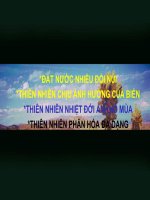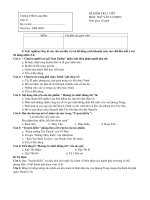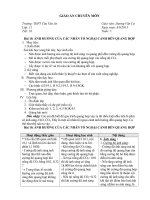bai 10 nature ingdanger listening
Bạn đang xem bản rút gọn của tài liệu. Xem và tải ngay bản đầy đủ của tài liệu tại đây (126.46 KB, 5 trang )
<span class='text_page_counter'>(1)</span>PLANNING LESSON Introduction: 1. Name: Đặng Thị Hồng Quí 2. Lesson: Unit 10: Nature in Danger C. Listening Class: English 11 3. Objectives: By the end of the lesson, students will be able to: - Develop listening skills about specific and general information; - Help students know clearly situation of national parks; - Use the information they have listened to talk about their own opinion about national parks and the others. 4. Materials: course book, posters, projectors, cassette;. Procedures: I.. Contents Warm up:. - Words square game.. Teacher/ Students’ activities T: - Hang the poser with “words square” on the board and divides. - Objective: to guide Ss to the lesson class into two groups (group A&B) and lead in the topic of the listening. - Explain the game’s rules: - The things in natural world:. + Topic: the things are belong to natural world;. 1. habitats. + They can be in vertical, horizontal or diagonal line.. 2. flowers. + The word only contains from 6 to 9 letters.. 3. forests. + Group who has more correct words will win.. 4. oceans. - Lead in: Say: “These things are in our natural world. Most. 5. animals. of them are being protected in many places, especially in. 6. plants. national parks. However; national parks are also facing with. Words square:. more problems. Today, we will continue Unit 10: Nature in Danger; Part C. Listen to get more information about this. Time 5’.
<span class='text_page_counter'>(2)</span> S S R E W O L F II.. S L A M I T O T R E B A C T S I Y T E T R O J I A D S E A B W O O D Z O R E S T Pre-listening:. N S E E N N A S. A P L A N T S H. 1. Pre-teach vocabulary: Vocabulary:. situation. Ss: - Work in group and show only one word on the board.. - Elicit vocabularies by:. 8’. T: + Ask: “What is another word for “destroyed”?”(synonym) + Ask: “How can you say “đặc điểm phong cảnh” in. + devastating (adj): hủy hoại,. English”(Translation). tàn phá. + Ask: “How can you say “cars, buses, etc in general. + scenic feature (n). ”(Translation). : đặc điểm phong cảnh. + Another word for “include” ( synonym). + contain (v): bao gồm. - Ask: “Tell me again the things in “word square that are. + vehicles (n): xe cộ. being protected in national parks?. Brainstorming:. - Ask some questions to lead-in: “Have you ever visited national park? Where? Can you give me some names of national parks in Vietnam? Do you think it will have similarities to national parks in the United States? -Lead in: “to answer this question we are going to listen about man talking about national parks in the United States.” Ss:. III.. While-listening:. - Listen to T, answer the questions. T:. Task 1. Listen to the passage and. -. Hang posters on the board;. decide if the following statements. -. Run-through some words:. are true (T) or false (F). (Ss’ book on page 119). Scenic features Devastating. Maintenance. 25’.
<span class='text_page_counter'>(3)</span> 1.T 2.T 3.F 4.T 5.T. Approximately -. Vehicles. Completely. Explains carefully to make sure that Ss know the statements in T/F task clearly;. -. Let Ss make predictions;. -. Check Ss’ answers;. -. Let Ss listen to 2 times.. Ss T and: Listen to T and give opinions;. Task 2. Listen again and answer. T: -. the questions.( Ss’ book on page. -. Make sure that Ss can know the meaning of questions;. 119). -. Let Ss work in a group of 3;. -. Let Ss listen to 2 times.. -. Listen to T and take notes;. -. Answer the questions.Listen to the passage and take. Hang the poster;. Ss:. notes. IV.. Post-listening:. T:. 4’. Ask Ss to summarize the passage. -. Let Ss listen again;. base on Task 1 and Task 2.. -. Ask them summarize.. -. Give feedback.. V.. Homwork:. Ss: - Work in pairs and give opinions. T:. Ask Ss two questions:. -. Hang poster and ask Ss copy down;. 1. What are the problems that. -. Ask Ss prepare next lesson.. national parks facing? 2. How can we do to protect national parks? Key:. Ss: Listen to T and take notes. ]T: Teacher. Ss: Students. 3’.
<span class='text_page_counter'>(4)</span> Task1. Listen to the passage and decide if the following statements are true (T) or false (F). 1. National parks protect and preserve the natural of the land. 2. They usually contain a variety of scenic features. 3. All national parks are in danger of being destroyed. 4. Large areas of national parks can be destroyed by fire. 5. Visitors do not help to preserve and protect national parks.. T T T. F T. T T. Task 2. Listen again and answer the questions. 1. How many national parks are there in the United States? There are 52 national parks in the United States. 2. How many people visit national parks every year? Millions of people visit national parks every year. 3. Can you name some of the problems which national parks are currently facing? Rare animals are killed or hunted for fur, skin, or other parts; Trees are cut down for wood; Large areas of national parks experience devastating fires caused by careless people; The increasing number of visitors is harming the parks due to pollution from their vehicles. 4. What should be done to protect them? Rare animals and trees should be protected; Fires caused by careless people should be limited; Pollution from the visitors’ vehicles should be decreased; Money should be raised for the parks’ staff and maintenance of their resources. Tape script:.
<span class='text_page_counter'>(5)</span> In many parts of the United States, large areas of land have been made into national parks to protect and preserve the natural beauty of the land. National parks usually contain a variety of scenic features, such as mountains, caves, laves, rare animals and plants. Today, there are 52 national parks in the United States, covering approximately 3 percent of total land area of country. National parks are all open to the public and have millions of visitors each year. Many national parks, however, are in danger of being destroyed. Rare animals in national parks are killed or hunted for fur, skin, or other parts. Trees are cut down for wood. Large areas of national parks experience devastating fire cause by careless people. The increasing number of visitors is harming the parks due to pollution from their vehicles. If these problems are not solved immediately, and if there is not enough money for the parks’ staff and maintenance of their resources, many national parks will be completely destroyed..
<span class='text_page_counter'>(6)</span>









